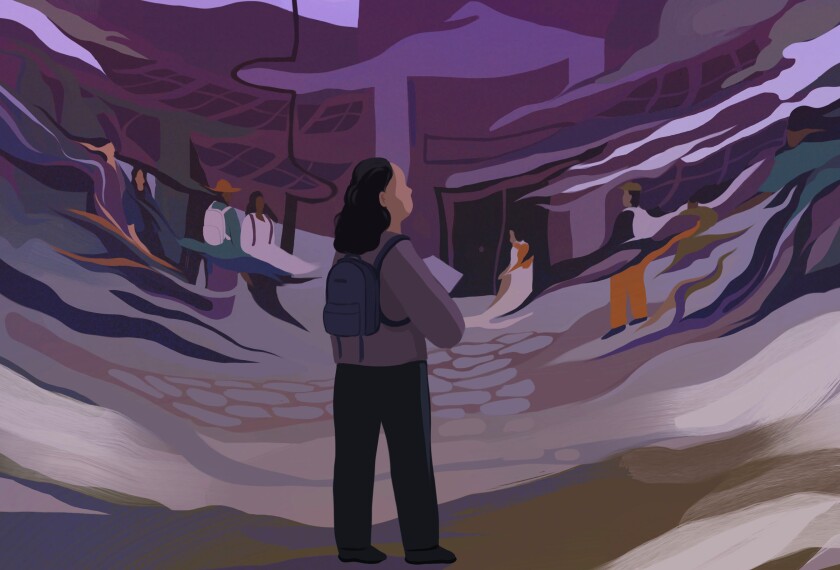The number of students in special education has increased steadily in the last four decades, with parents more readily seeking additional support and more students being diagnosed with conditions, like attention deficit hyperactivity disorder and autism spectrum disorder.
In the wake of the pandemic, though, districts struggle to hire and—more importantly—keep their special education teachers, who are often beleaguered by stressful working conditions and a lack of resources.
Even as the field shifts to address workforce shortages, with some states considering extra pay for special education and others eyeing how artificial intelligence could lessen the burden of increased workloads, students with disabilities make up roughly 13 percent of the school population, said Natasha Strassfeld, an assistant professor in the department of special education at the University of Texas at Austin.
These are key terms educators should know.

The Individuals with Disabilities Education Act, or IDEA, is a federal law that establishes the rights of students with disabilities and their families.
First passed in 1975 and most recently reauthorized in 2004, the act provides grant funding to states that agree to the federal government’s vision for educating students with disabilities, said Strassfeld.
Students must be identified, evaluated, and deemed as IDEA eligible for the state to use federal money to educate that child. There are 13 categories under which a student could be eligible, including physical and intellectual disabilities.
There are about seven million students served under IDEA, said Strassfeld.

An Individualized Education Program, or IEP, is a legally binding contract between a school district and a family with a child with a disability. Under IDEA, students are afforded an IEP, said Dia Jackson, senior researcher for special education, equity, and tiered systems of support at the American Institutes of Research.
IEPs spell out what area a student has a disability in, how it impacts learning, and what the school will do to address those needs, such as providing speech or occupational therapy, more intensive instructional supports, and accommodations, including for standardized tests and other learning goals.
The number of IEPs is increasing in schools as conditions, like autism spectrum disorder, or ADHD, are being diagnosed more readily.

All students with disabilities are protected under Section 504 of the Rehabilitation Act of 1973, which requires schools to make “reasonable accommodation” for students with disabilities.
Educators don’t have to make specially designed instruction plans under a 504, but students can get certain accommodations, like elevator passes if a student is in a wheelchair, Jackson said.
“It’s a slightly different focus, but both play out in schools,” Jackson said.

Individualized family services plans, or IFSPs, are developed for children up to age 3 who need help with communication, social-emotional skills, and physical needs, Strassfeld said.
Like an IEP, the plan is made in collaboration with a parent or guardian, along with professionals such as a child care provider, religious leaders, or doctors. The document outlines a plan for families to help seek services—such as speech and language therapy, occupational therapy, medical services, and more—but is focused more on the family’s goals rather than strictly educational goals, Strassfeld said.
“While they’re focusing on pre-education goals, primarily at that age, we’re thinking about that child as being a part of a component of a family,” she said.

The right to a Free Appropriate Public Education, or FAPE, means that for every IDEA-eligible student, services must be provided at no cost to the student or their family, must be appropriate for the needs of the child, and have to be education oriented, Strassfeld said.
With FAPE, there is also the concept of least restrictive environment, or LRE, Jackson said. Students should be included to the fullest extent possible in mainstream classrooms and be challenged but appropriately supported, alongside their general education peers.
That’s not without its challenges, however, Strassfeld said.
“IDEA essentially is premised on the philosophical notion that it is that easy. It’s a real challenge for school districts,” she said, adding that as parents and advocates examine special education through disability justice and disability studies lenses, there are more critiques of the model.
Jackson said that she’s heard criticism along these lines: When students with disabilities aren’t prepared for a general education environment, or when general education teachers don’t have training on special education.

Response to intervention, or RTI, came as an amendment to IDEA in 2004 to help earlier identify students who are struggling before they begin failing, Jackson said, and begin giving them additional support through a tiered process. Generally, all students receive “tier I” instruction on grade-level standards. Then, students who need additional help get more intensive supports. That could look like a teacher working one-on-one, or in small groups, helping target specific areas to improve learning.
Intervention is an evidence-based program meant to address a specific learning or social-emotional need. It can be done in a general education classroom, and looks like regular teaching, Jackson said, but it uses particular materials and involves collecting data on progress.
The term RTI has evolved into multitiered system of supports, or MTSS, which is also a preventative framework, but goes beyond academics to consider the infrastructure districts need to implement MTSS, Jackson said.
“The shift to MTSS is meant to be more inclusive of the infrastructure as well as inclusive of social-emotional learning as well as academics,” she said.

A functional behavior assessment, or FBA, is a way for educators to collect data on student behavior, and what is triggering certain unwanted behavior, Jackson said.
For instance, she said, if a teacher has a student who has autism and, when they get upset, they throw a chair, an FBA could be conducted.
Once that analysis is collected, a behavior intervention plan, or BIP, is developed, describing what the behavior is, how often it happens, and what will be done to address it.
FBAs and BIPs are not without concerns, however, as students with disabilities—especially students of color—are more likely to face exclusionary discipline, such as suspension and expulsion.
“A lot of times, it is a subjective judgment call if a student is exhibiting ‘appropriate behavior’ or not,” Jackson said. “There’s a lot of potential bias that goes into discipline of students and behavior management.”
It’s one example of disproportionality, where an ethnic or racial group is over- or under-represented in certain areas. For instance, Jackson said, students of color with disabilities are over-represented in discipline, on being identified as having a disability, and being placed in more restrictive environments.

Restraint and seclusion are practices used in public schools as a response to student behavior that limits their movement and aims to deescalate them, by either physically limiting their movement (restraint) or isolating them from others (seclusion), according to previous EdWeek reporting.
The practice of physically restraining students with disabilities or placing them in isolation has been heavily scrutinized, but is still used in some states.
It should only be used in extreme cases when a student is at risk to harm themselves or others, Jackson said, but never as a behavior management technique, or as punishment. Students have been harmed, or even killed, as a result of restraints, Jackson said. Students of color are over-represented in the population who are restrained and isolated, Jackson added.
Even still, there are educators who don’t want to see the practices completely banned, Jackson said.
“Teachers have been hurt by students or they’ve been hurt in the midst of a restraint so they still want to have the option available,” she said. “It’s an issue of not having training in another alternative, so they feel like: ‘This is the only way I can handle this particular student, or type of student, because I don’t know anything else.’”
Strassfeld said that there’s been more focus on the practice alongside excessive force in law enforcement.
“There’s been discussion that disability advocates have had about criminalization of behaviors that a person has no control over, and this type of force seems to deny the humanity of people who perhaps are exhibiting behaviors they are not able to control,” she said.







